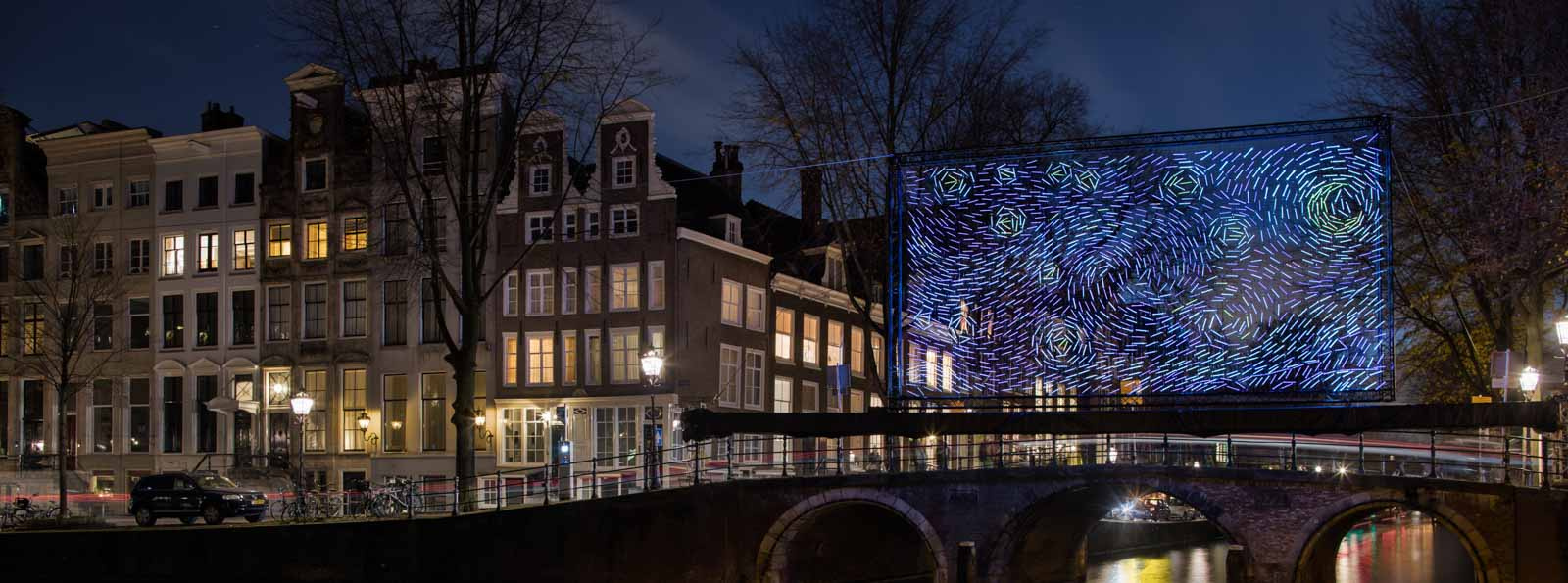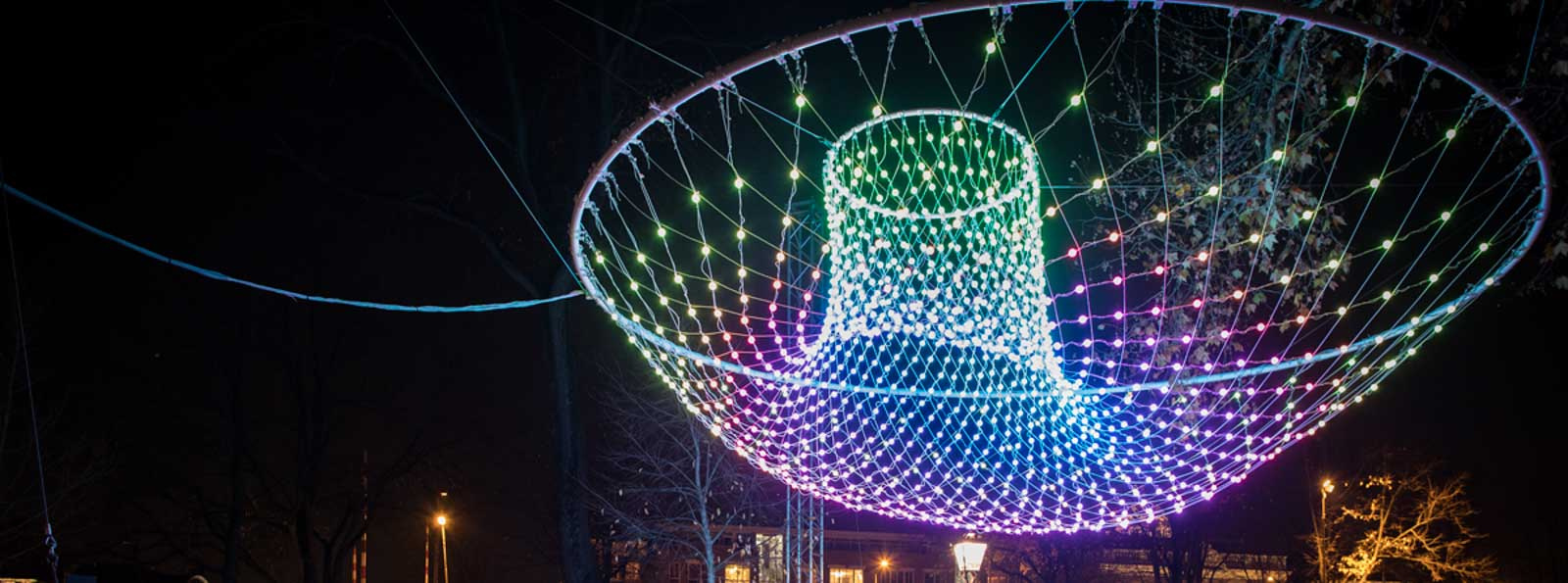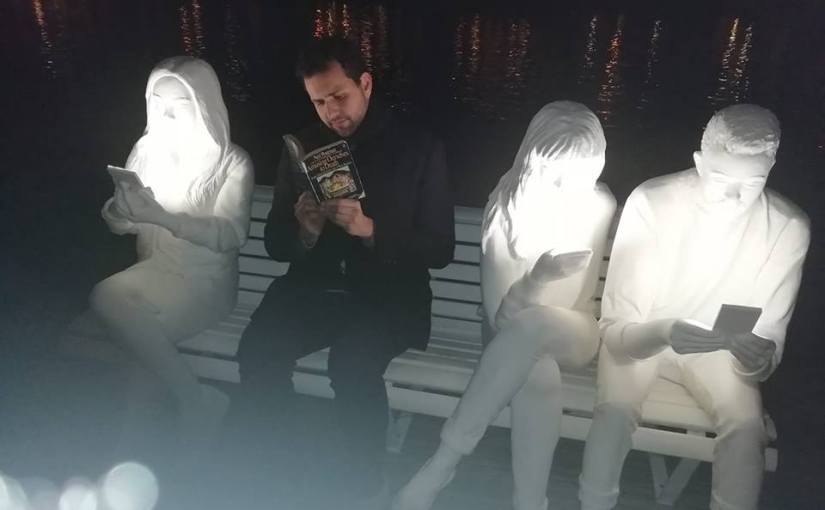These days, and until the 20th of January, the Amsterdam Light Festival is taking place. During the festival, 30 light artworks are being displayed around Amsterdam, all related to this edition’s theme ‘The Medium is the Message’.
The quote “the medium is the message” comes from the famous media theorist, Marshall McLuhan. McLuhan wrote that in 1964, to refer to the fact that each message is defined by the medium used to convey it. The same message would have different effects if it appeared on a newspaper than what it would have if it appeared on TV.
We can ask ourselves then if all these artworks are media with different messages. In a sense, yes. McLuhan would say that media are divided between “cold” and “hot”: hot media present us with all the information necessary, whereas cold media require us to do the work and think of the message. In addition, the city of Amsterdam is a great medium for messages to be circulated and stories to be told. Having collaborated with one of the official Amsterdam Light Festival partners, I had the opportunity to see some of the sculptures and select a few favourite ones to analyse here. Following is a description of how some of the artwork resonated with me and the kind of messages it sent me. Keep in mind that the text here is not an official explanation from the artists; it is just the connections a media researcher made thinking about the sculptures, contemporary society, and Amsterdam.
A.N.N.

A.N.N. stands for Artificial Neural Network. I find quite clever the fact that the neural network has different lights flashing on and off. The different lights represent information that goes through our brain. As you can see, the information -the message- comes, goes and intersects with other information, thus creating a constant, never ending flow of data. Could it be useful information? Could it be useless? No one knows. I find it as an accurate representation of today’s era where the influx of information is endless.
Starry Night

This is a copy of van Gogh’s Starry Night. The original Starry Night is located in New York (or New Amsterdam, as it was used to be known centuries ago). Now, we are presented with a copy of an artwork that is also a copy, since the painting is a representation of an actual sky. So, in a sense we have a copy of a copy, making us wonder if there is anything original in this world or if everything we know as original is actually a fake. The first painting (the old Starry Night) is in New Amsterdam, whereas the light sculpture (the new painting) is in old Amsterdam, creating this way an entertaining paradox.
Two Lamps
-HEADERS2017.jpg)
McLuhan wrote specifically about the light that it is also a medium of communication, since by illuminating dark spaces, human communication can take place where it initially could not. And this artwork here shows exactly this: the human communication can not only take place in the dark, but also in the water since the lamps point directly in the canal. By conquering water, darkness, and all other natural obstacles, humanity has imposed itself on nature through mechanical means.
Midnight Summer Dream
-HEADERS2017.jpg)
Here we have a collection of lanterns. But these lanterns are all made by washing machine barrels. The sculpture reminds us of Shakespeare’s play of the similar name ‘A Midsummer Night’s Dream’. A central location of that play is the land of the fairies. Like fairies, these lanterns ‘fly’ above the canals and illuminate them. Also, in the same play, the character Bottom is transformed into a donkey by the character Puck. I find quite funny the fact that this sculpture is also about transformation: a medium of cleaning (washing machine barrel) is converted into a medium of illumination (lantern).
Parabolic Lightcloud

This one is about emotions. The different colours can be read as various emotions. A human personality is complex, being constituted of all sorts of emotions that change from one moment to another. The come, they go, and they intersect, showing us that human beings do not feel the same things at all times. We are all a vortex of emotions; a vortex of colours.
Absorbed By Light

One of my favourites. We see these people being here, but their mind is probably somewhere else. They receive all this information from their screens, but what do they really get? In his book ‘Amusing Ourselves to Death’, Neil Postman suggests that we live in a society where entertainment prevails over information and education: it is not that we cannot access information –it is that we just don’t care about it. Postman also mentions that story of a student that would read a book by having his back turned on a TV set, using the light of the screen to illuminate the pages, because that was, Postman claims, television’s only good use. I am pretty sure Postman would have thought the same utility for a phone or a tablet too. I prefer being a bit more optimistic and give some agency to the people of the sculpture. I’d like to think that they are actually using their devices to learn something useful, instead of just wasting their time.
Night Vision
-HEADERS2017.jpg)
This sculpture represents an eye. But an eye is generally a medium of reception: all visual information goes through the eye first, and then it is processed by the brain. This particular sculpture creates an interesting paradox: it is an eye that emanates light, thus it becomes a sender of information instead of a recipient. Art can really show different ways of how things work.
Virtual Fairground

No better area than the Damrak could host this sculpture that reminds of entertainment, fairs and carnivals. Virtual Fairground is the representation of fun, and it is located on a street that offers an abundance of game halls, stores, and lights (not only during the festival): a real carnival that takes places on a daily basis. I do not find coincidental the fact that Primark (a global chain) is across the artwork, with the stock market behind it. That brings to mind connections to globalization and capitalism being presented in a nice, entertaining, gift-wrapped package, numbing our senses and inviting us to have a good time, ignoring what is really happening in the world. Of course, I don’t believe all of this has anything to do with the artist’s original reason. It is just the observation of someone who is feeling very postmodern today. After all, we all receive art differently.
If you want to take a guided tour to see these sculptures and more, you can book at the website of A-Bike.
All pictures are taken by Janus van den Eijnden, except from the picture of myself next to the Absorbed By Light sculpture.
